Quality Management Report: Analysis of Toyota's Business Strategies
VerifiedAdded on 2020/10/22
|11
|3052
|298
Report
AI Summary
This report provides a comprehensive analysis of quality management practices, using Toyota as a case study. It begins by defining quality in a business context and illustrating inspection and assurance processes. The report then explores various quality management approaches, including those of Edwards Demings and Philip Crosby, highlighting their similarities and differences. It delves into the significance of customer satisfaction and continuous improvement, examining the value added through these processes. Furthermore, the report discusses the types of information provided to customers and methods for measuring quality management. It evaluates the benefits of user and non-user surveys in determining customer needs and identifies the value of complaint procedures in improving quality. Finally, the report examines the role of self-assessment, communication, and record-keeping in maintaining quality standards, concluding with a summary of key findings and references.
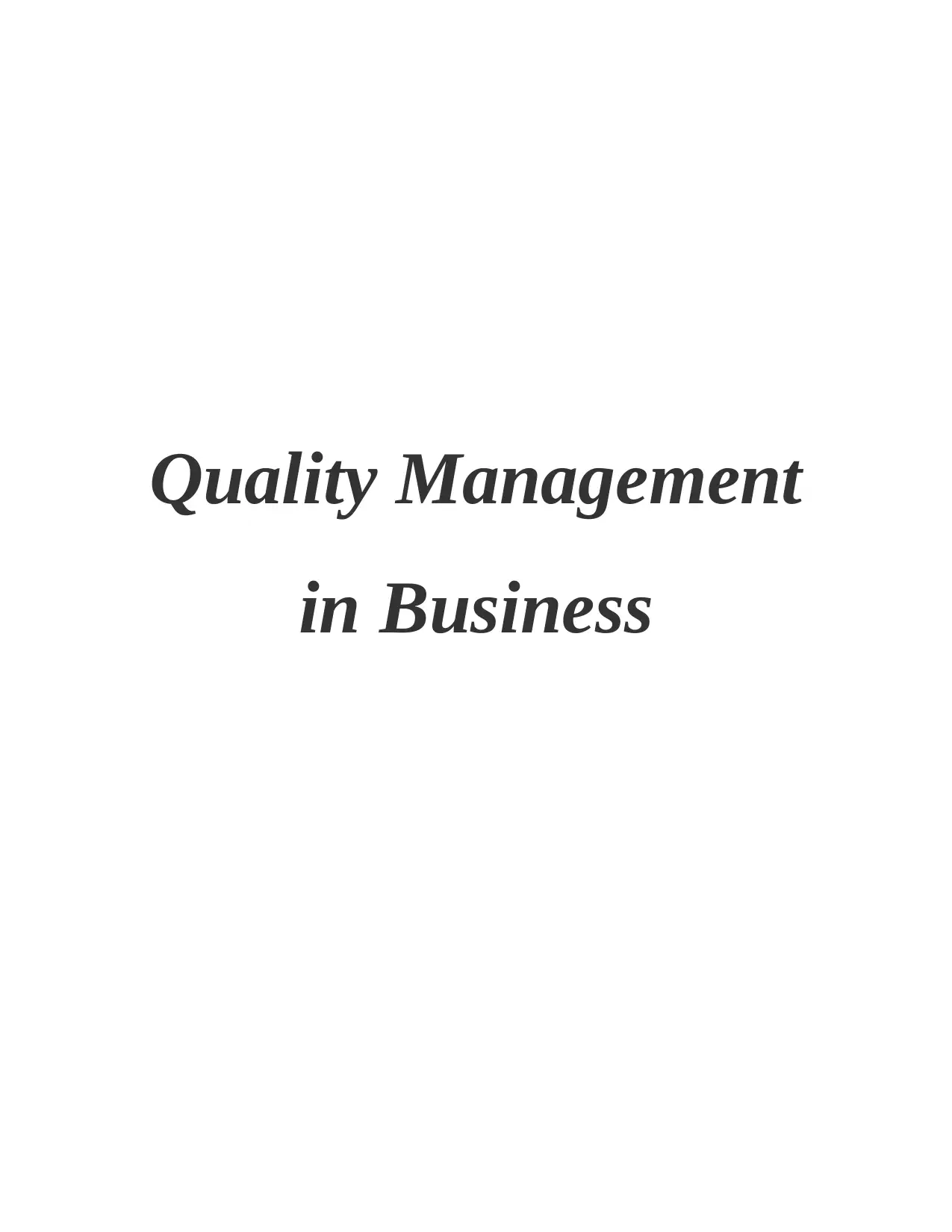
Quality Management
in Business
in Business
Paraphrase This Document
Need a fresh take? Get an instant paraphrase of this document with our AI Paraphraser
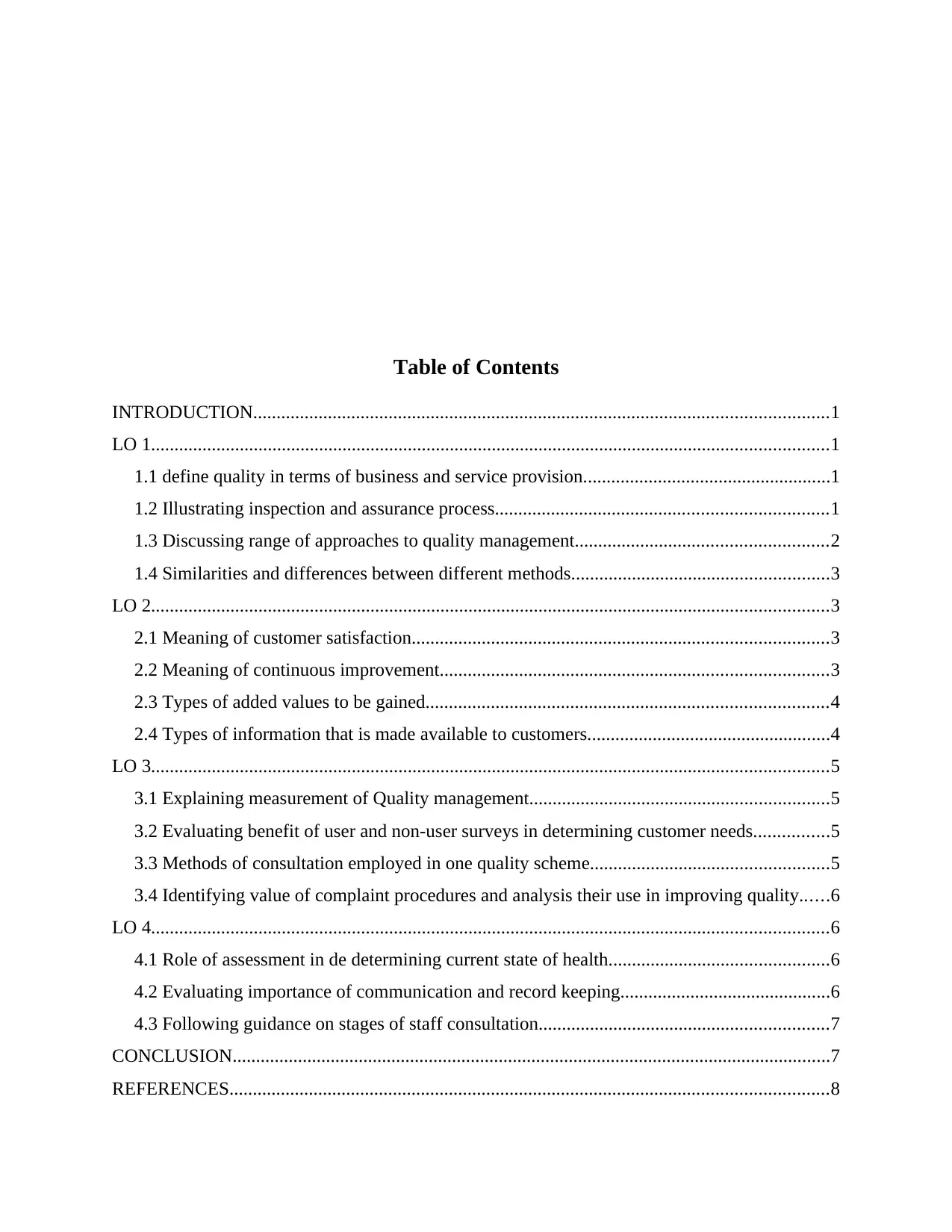
Table of Contents
INTRODUCTION...........................................................................................................................1
LO 1.................................................................................................................................................1
1.1 define quality in terms of business and service provision.....................................................1
1.2 Illustrating inspection and assurance process.......................................................................1
1.3 Discussing range of approaches to quality management......................................................2
1.4 Similarities and differences between different methods.......................................................3
LO 2.................................................................................................................................................3
2.1 Meaning of customer satisfaction.........................................................................................3
2.2 Meaning of continuous improvement...................................................................................3
2.3 Types of added values to be gained......................................................................................4
2.4 Types of information that is made available to customers....................................................4
LO 3.................................................................................................................................................5
3.1 Explaining measurement of Quality management................................................................5
3.2 Evaluating benefit of user and non-user surveys in determining customer needs................5
3.3 Methods of consultation employed in one quality scheme...................................................5
3.4 Identifying value of complaint procedures and analysis their use in improving quality......6
LO 4.................................................................................................................................................6
4.1 Role of assessment in de determining current state of health...............................................6
4.2 Evaluating importance of communication and record keeping.............................................6
4.3 Following guidance on stages of staff consultation..............................................................7
CONCLUSION................................................................................................................................7
REFERENCES................................................................................................................................8
INTRODUCTION...........................................................................................................................1
LO 1.................................................................................................................................................1
1.1 define quality in terms of business and service provision.....................................................1
1.2 Illustrating inspection and assurance process.......................................................................1
1.3 Discussing range of approaches to quality management......................................................2
1.4 Similarities and differences between different methods.......................................................3
LO 2.................................................................................................................................................3
2.1 Meaning of customer satisfaction.........................................................................................3
2.2 Meaning of continuous improvement...................................................................................3
2.3 Types of added values to be gained......................................................................................4
2.4 Types of information that is made available to customers....................................................4
LO 3.................................................................................................................................................5
3.1 Explaining measurement of Quality management................................................................5
3.2 Evaluating benefit of user and non-user surveys in determining customer needs................5
3.3 Methods of consultation employed in one quality scheme...................................................5
3.4 Identifying value of complaint procedures and analysis their use in improving quality......6
LO 4.................................................................................................................................................6
4.1 Role of assessment in de determining current state of health...............................................6
4.2 Evaluating importance of communication and record keeping.............................................6
4.3 Following guidance on stages of staff consultation..............................................................7
CONCLUSION................................................................................................................................7
REFERENCES................................................................................................................................8

⊘ This is a preview!⊘
Do you want full access?
Subscribe today to unlock all pages.

Trusted by 1+ million students worldwide
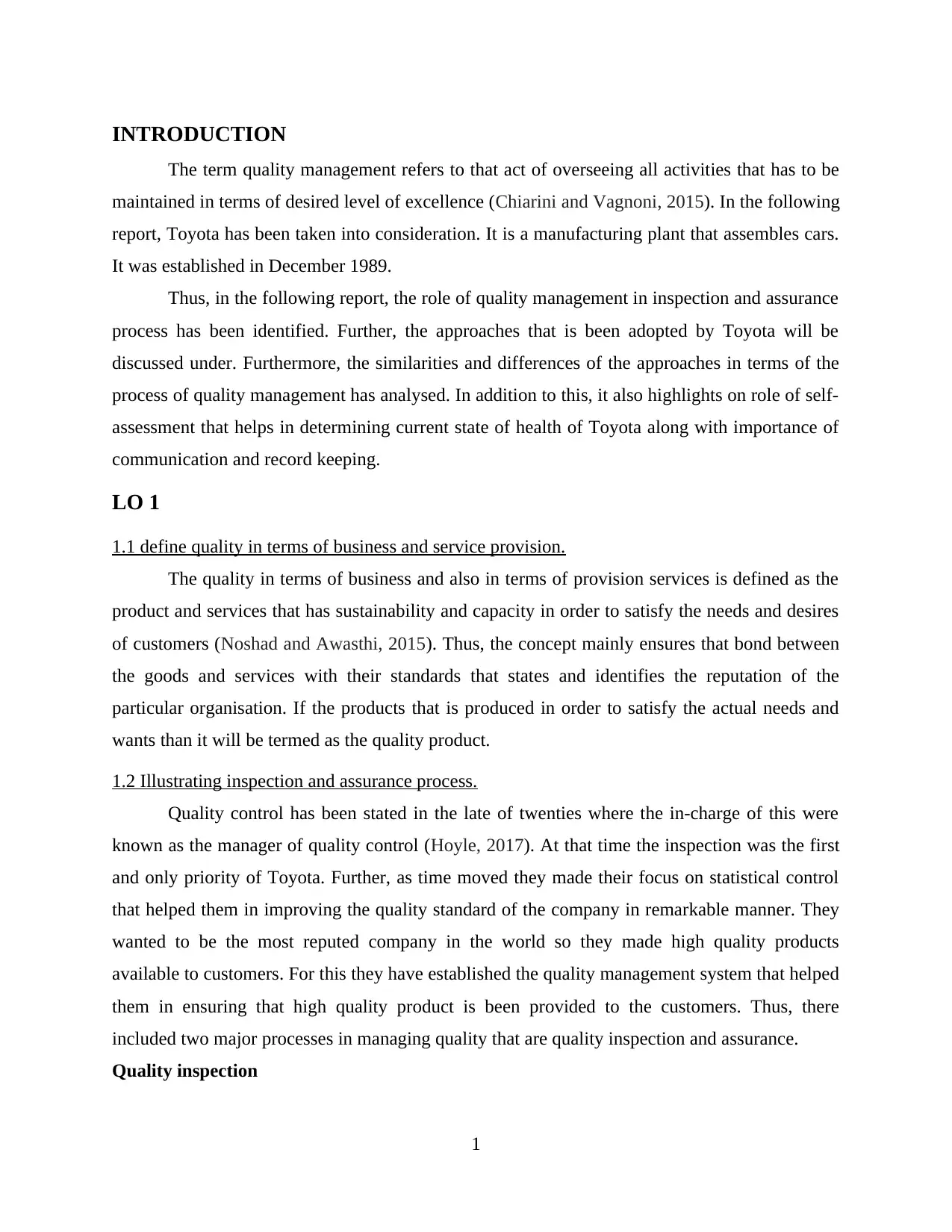
INTRODUCTION
The term quality management refers to that act of overseeing all activities that has to be
maintained in terms of desired level of excellence (Chiarini and Vagnoni, 2015). In the following
report, Toyota has been taken into consideration. It is a manufacturing plant that assembles cars.
It was established in December 1989.
Thus, in the following report, the role of quality management in inspection and assurance
process has been identified. Further, the approaches that is been adopted by Toyota will be
discussed under. Furthermore, the similarities and differences of the approaches in terms of the
process of quality management has analysed. In addition to this, it also highlights on role of self-
assessment that helps in determining current state of health of Toyota along with importance of
communication and record keeping.
LO 1
1.1 define quality in terms of business and service provision.
The quality in terms of business and also in terms of provision services is defined as the
product and services that has sustainability and capacity in order to satisfy the needs and desires
of customers (Noshad and Awasthi, 2015). Thus, the concept mainly ensures that bond between
the goods and services with their standards that states and identifies the reputation of the
particular organisation. If the products that is produced in order to satisfy the actual needs and
wants than it will be termed as the quality product.
1.2 Illustrating inspection and assurance process.
Quality control has been stated in the late of twenties where the in-charge of this were
known as the manager of quality control (Hoyle, 2017). At that time the inspection was the first
and only priority of Toyota. Further, as time moved they made their focus on statistical control
that helped them in improving the quality standard of the company in remarkable manner. They
wanted to be the most reputed company in the world so they made high quality products
available to customers. For this they have established the quality management system that helped
them in ensuring that high quality product is been provided to the customers. Thus, there
included two major processes in managing quality that are quality inspection and assurance.
Quality inspection
1
The term quality management refers to that act of overseeing all activities that has to be
maintained in terms of desired level of excellence (Chiarini and Vagnoni, 2015). In the following
report, Toyota has been taken into consideration. It is a manufacturing plant that assembles cars.
It was established in December 1989.
Thus, in the following report, the role of quality management in inspection and assurance
process has been identified. Further, the approaches that is been adopted by Toyota will be
discussed under. Furthermore, the similarities and differences of the approaches in terms of the
process of quality management has analysed. In addition to this, it also highlights on role of self-
assessment that helps in determining current state of health of Toyota along with importance of
communication and record keeping.
LO 1
1.1 define quality in terms of business and service provision.
The quality in terms of business and also in terms of provision services is defined as the
product and services that has sustainability and capacity in order to satisfy the needs and desires
of customers (Noshad and Awasthi, 2015). Thus, the concept mainly ensures that bond between
the goods and services with their standards that states and identifies the reputation of the
particular organisation. If the products that is produced in order to satisfy the actual needs and
wants than it will be termed as the quality product.
1.2 Illustrating inspection and assurance process.
Quality control has been stated in the late of twenties where the in-charge of this were
known as the manager of quality control (Hoyle, 2017). At that time the inspection was the first
and only priority of Toyota. Further, as time moved they made their focus on statistical control
that helped them in improving the quality standard of the company in remarkable manner. They
wanted to be the most reputed company in the world so they made high quality products
available to customers. For this they have established the quality management system that helped
them in ensuring that high quality product is been provided to the customers. Thus, there
included two major processes in managing quality that are quality inspection and assurance.
Quality inspection
1
Paraphrase This Document
Need a fresh take? Get an instant paraphrase of this document with our AI Paraphraser
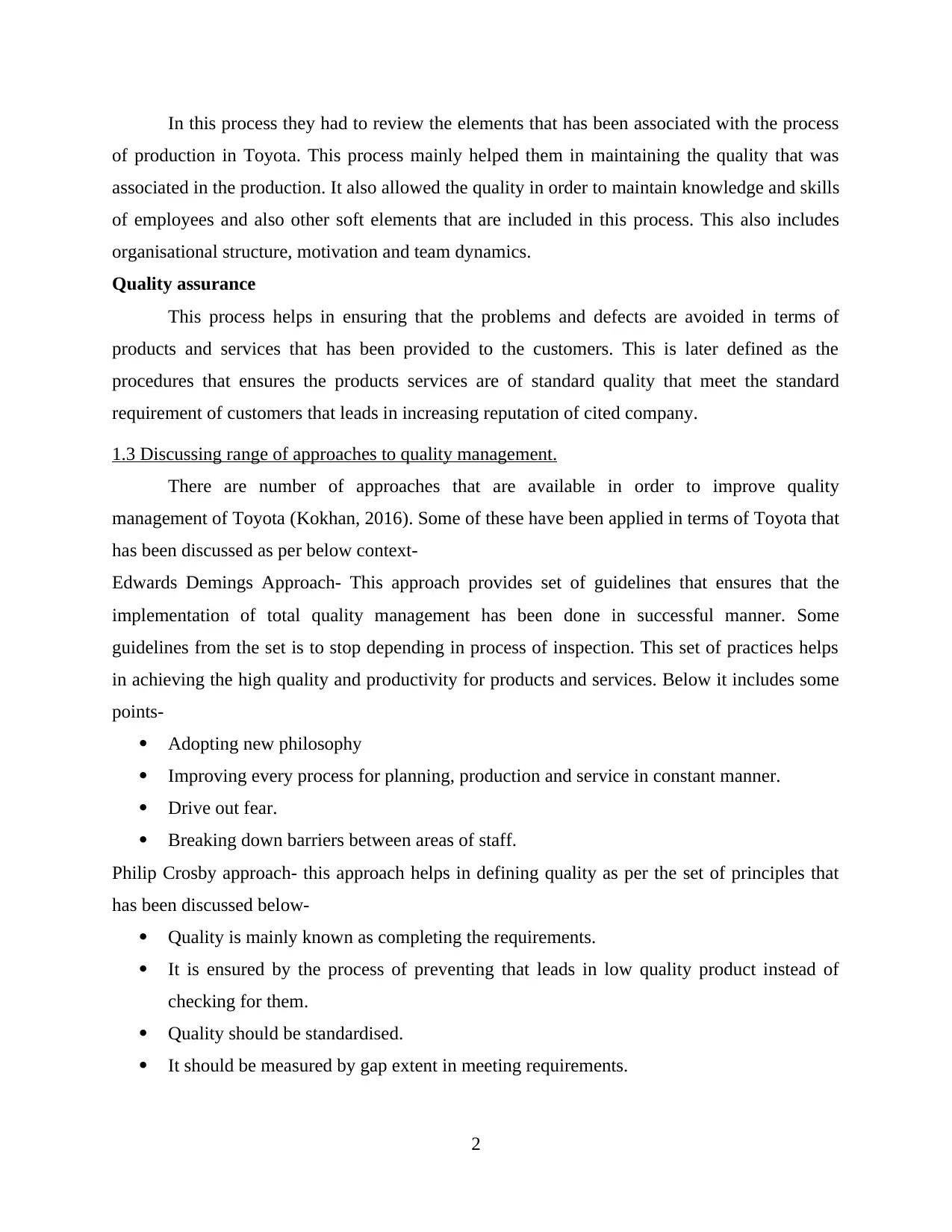
In this process they had to review the elements that has been associated with the process
of production in Toyota. This process mainly helped them in maintaining the quality that was
associated in the production. It also allowed the quality in order to maintain knowledge and skills
of employees and also other soft elements that are included in this process. This also includes
organisational structure, motivation and team dynamics.
Quality assurance
This process helps in ensuring that the problems and defects are avoided in terms of
products and services that has been provided to the customers. This is later defined as the
procedures that ensures the products services are of standard quality that meet the standard
requirement of customers that leads in increasing reputation of cited company.
1.3 Discussing range of approaches to quality management.
There are number of approaches that are available in order to improve quality
management of Toyota (Kokhan, 2016). Some of these have been applied in terms of Toyota that
has been discussed as per below context-
Edwards Demings Approach- This approach provides set of guidelines that ensures that the
implementation of total quality management has been done in successful manner. Some
guidelines from the set is to stop depending in process of inspection. This set of practices helps
in achieving the high quality and productivity for products and services. Below it includes some
points-
Adopting new philosophy
Improving every process for planning, production and service in constant manner.
Drive out fear.
Breaking down barriers between areas of staff.
Philip Crosby approach- this approach helps in defining quality as per the set of principles that
has been discussed below-
Quality is mainly known as completing the requirements.
It is ensured by the process of preventing that leads in low quality product instead of
checking for them.
Quality should be standardised.
It should be measured by gap extent in meeting requirements.
2
of production in Toyota. This process mainly helped them in maintaining the quality that was
associated in the production. It also allowed the quality in order to maintain knowledge and skills
of employees and also other soft elements that are included in this process. This also includes
organisational structure, motivation and team dynamics.
Quality assurance
This process helps in ensuring that the problems and defects are avoided in terms of
products and services that has been provided to the customers. This is later defined as the
procedures that ensures the products services are of standard quality that meet the standard
requirement of customers that leads in increasing reputation of cited company.
1.3 Discussing range of approaches to quality management.
There are number of approaches that are available in order to improve quality
management of Toyota (Kokhan, 2016). Some of these have been applied in terms of Toyota that
has been discussed as per below context-
Edwards Demings Approach- This approach provides set of guidelines that ensures that the
implementation of total quality management has been done in successful manner. Some
guidelines from the set is to stop depending in process of inspection. This set of practices helps
in achieving the high quality and productivity for products and services. Below it includes some
points-
Adopting new philosophy
Improving every process for planning, production and service in constant manner.
Drive out fear.
Breaking down barriers between areas of staff.
Philip Crosby approach- this approach helps in defining quality as per the set of principles that
has been discussed below-
Quality is mainly known as completing the requirements.
It is ensured by the process of preventing that leads in low quality product instead of
checking for them.
Quality should be standardised.
It should be measured by gap extent in meeting requirements.
2
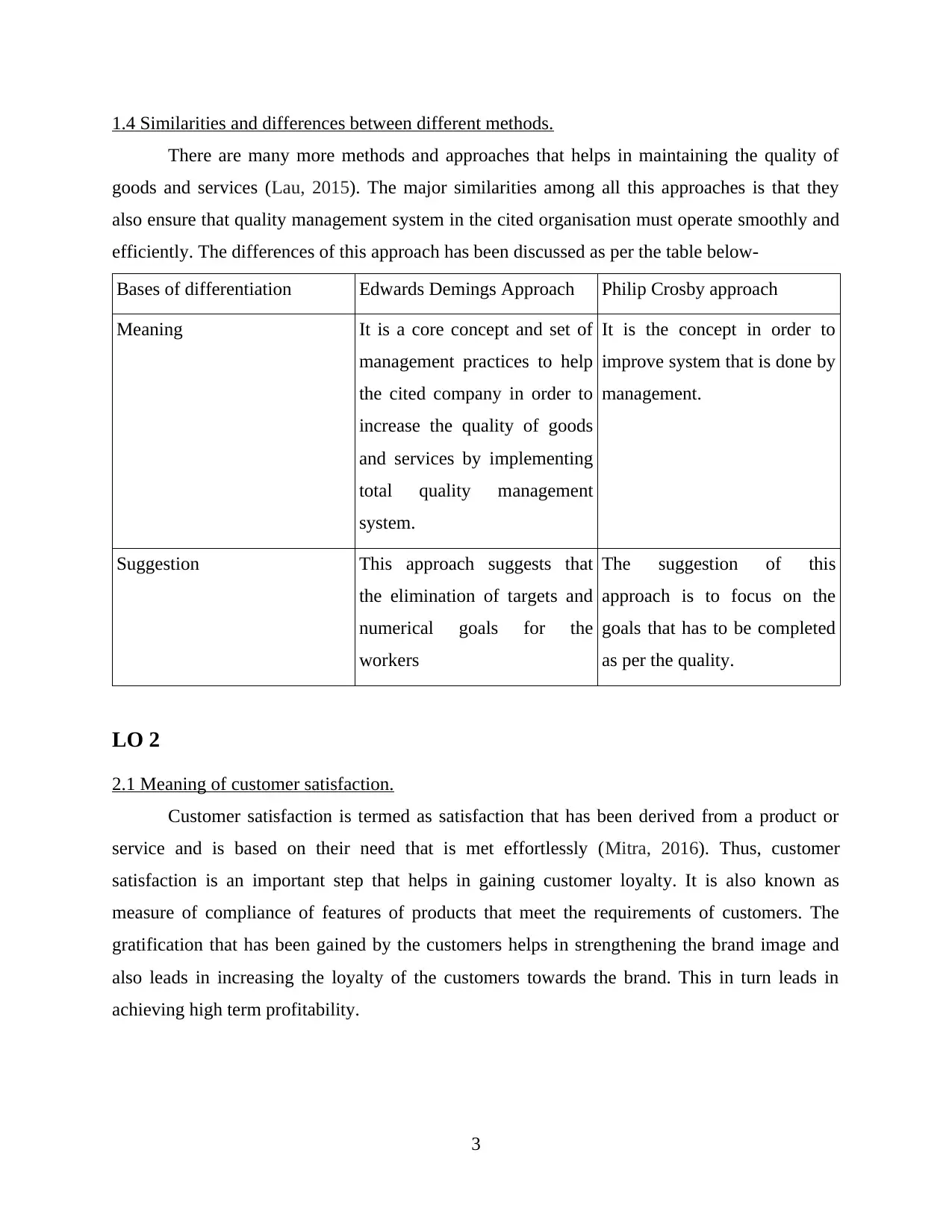
1.4 Similarities and differences between different methods.
There are many more methods and approaches that helps in maintaining the quality of
goods and services (Lau, 2015). The major similarities among all this approaches is that they
also ensure that quality management system in the cited organisation must operate smoothly and
efficiently. The differences of this approach has been discussed as per the table below-
Bases of differentiation Edwards Demings Approach Philip Crosby approach
Meaning It is a core concept and set of
management practices to help
the cited company in order to
increase the quality of goods
and services by implementing
total quality management
system.
It is the concept in order to
improve system that is done by
management.
Suggestion This approach suggests that
the elimination of targets and
numerical goals for the
workers
The suggestion of this
approach is to focus on the
goals that has to be completed
as per the quality.
LO 2
2.1 Meaning of customer satisfaction.
Customer satisfaction is termed as satisfaction that has been derived from a product or
service and is based on their need that is met effortlessly (Mitra, 2016). Thus, customer
satisfaction is an important step that helps in gaining customer loyalty. It is also known as
measure of compliance of features of products that meet the requirements of customers. The
gratification that has been gained by the customers helps in strengthening the brand image and
also leads in increasing the loyalty of the customers towards the brand. This in turn leads in
achieving high term profitability.
3
There are many more methods and approaches that helps in maintaining the quality of
goods and services (Lau, 2015). The major similarities among all this approaches is that they
also ensure that quality management system in the cited organisation must operate smoothly and
efficiently. The differences of this approach has been discussed as per the table below-
Bases of differentiation Edwards Demings Approach Philip Crosby approach
Meaning It is a core concept and set of
management practices to help
the cited company in order to
increase the quality of goods
and services by implementing
total quality management
system.
It is the concept in order to
improve system that is done by
management.
Suggestion This approach suggests that
the elimination of targets and
numerical goals for the
workers
The suggestion of this
approach is to focus on the
goals that has to be completed
as per the quality.
LO 2
2.1 Meaning of customer satisfaction.
Customer satisfaction is termed as satisfaction that has been derived from a product or
service and is based on their need that is met effortlessly (Mitra, 2016). Thus, customer
satisfaction is an important step that helps in gaining customer loyalty. It is also known as
measure of compliance of features of products that meet the requirements of customers. The
gratification that has been gained by the customers helps in strengthening the brand image and
also leads in increasing the loyalty of the customers towards the brand. This in turn leads in
achieving high term profitability.
3
⊘ This is a preview!⊘
Do you want full access?
Subscribe today to unlock all pages.

Trusted by 1+ million students worldwide
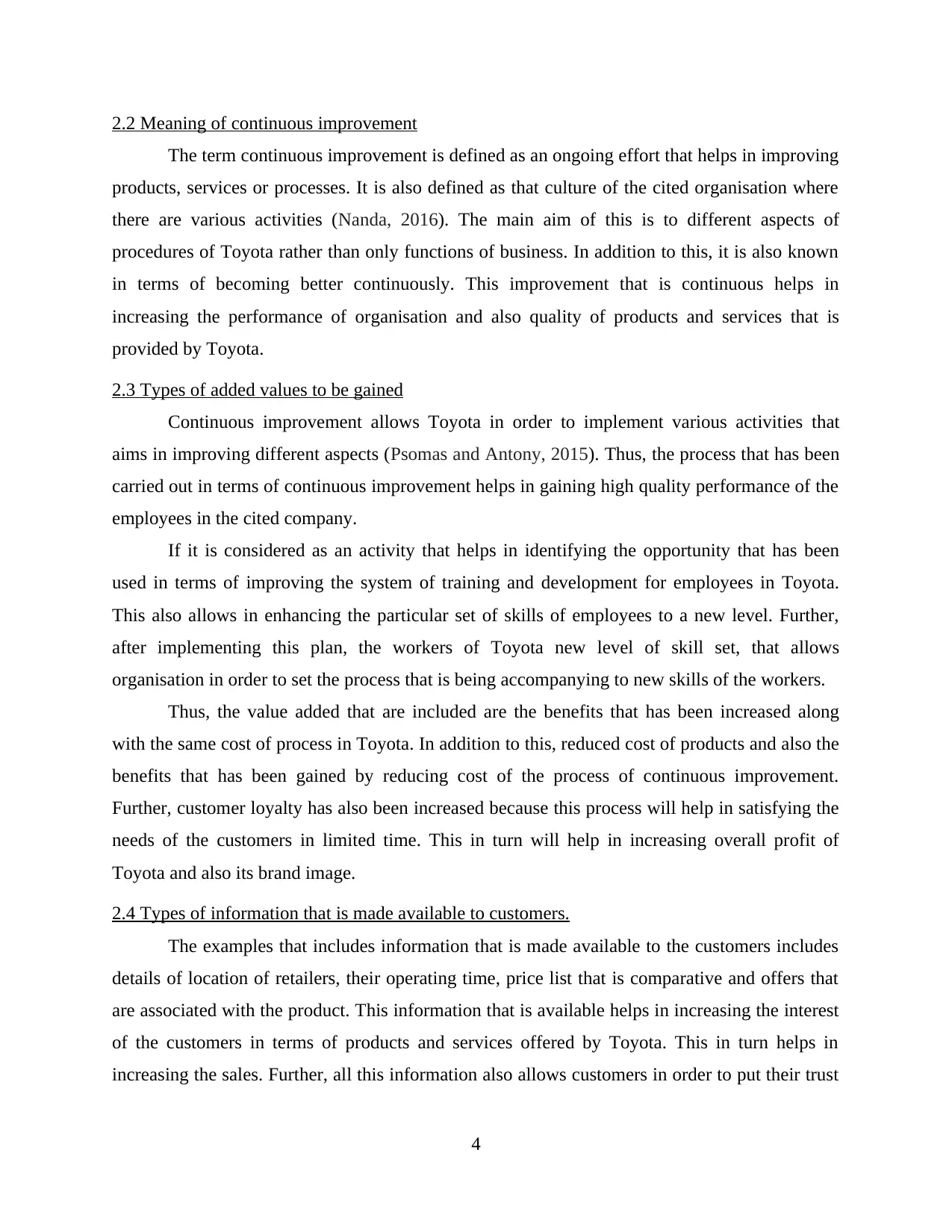
2.2 Meaning of continuous improvement
The term continuous improvement is defined as an ongoing effort that helps in improving
products, services or processes. It is also defined as that culture of the cited organisation where
there are various activities (Nanda, 2016). The main aim of this is to different aspects of
procedures of Toyota rather than only functions of business. In addition to this, it is also known
in terms of becoming better continuously. This improvement that is continuous helps in
increasing the performance of organisation and also quality of products and services that is
provided by Toyota.
2.3 Types of added values to be gained
Continuous improvement allows Toyota in order to implement various activities that
aims in improving different aspects (Psomas and Antony, 2015). Thus, the process that has been
carried out in terms of continuous improvement helps in gaining high quality performance of the
employees in the cited company.
If it is considered as an activity that helps in identifying the opportunity that has been
used in terms of improving the system of training and development for employees in Toyota.
This also allows in enhancing the particular set of skills of employees to a new level. Further,
after implementing this plan, the workers of Toyota new level of skill set, that allows
organisation in order to set the process that is being accompanying to new skills of the workers.
Thus, the value added that are included are the benefits that has been increased along
with the same cost of process in Toyota. In addition to this, reduced cost of products and also the
benefits that has been gained by reducing cost of the process of continuous improvement.
Further, customer loyalty has also been increased because this process will help in satisfying the
needs of the customers in limited time. This in turn will help in increasing overall profit of
Toyota and also its brand image.
2.4 Types of information that is made available to customers.
The examples that includes information that is made available to the customers includes
details of location of retailers, their operating time, price list that is comparative and offers that
are associated with the product. This information that is available helps in increasing the interest
of the customers in terms of products and services offered by Toyota. This in turn helps in
increasing the sales. Further, all this information also allows customers in order to put their trust
4
The term continuous improvement is defined as an ongoing effort that helps in improving
products, services or processes. It is also defined as that culture of the cited organisation where
there are various activities (Nanda, 2016). The main aim of this is to different aspects of
procedures of Toyota rather than only functions of business. In addition to this, it is also known
in terms of becoming better continuously. This improvement that is continuous helps in
increasing the performance of organisation and also quality of products and services that is
provided by Toyota.
2.3 Types of added values to be gained
Continuous improvement allows Toyota in order to implement various activities that
aims in improving different aspects (Psomas and Antony, 2015). Thus, the process that has been
carried out in terms of continuous improvement helps in gaining high quality performance of the
employees in the cited company.
If it is considered as an activity that helps in identifying the opportunity that has been
used in terms of improving the system of training and development for employees in Toyota.
This also allows in enhancing the particular set of skills of employees to a new level. Further,
after implementing this plan, the workers of Toyota new level of skill set, that allows
organisation in order to set the process that is being accompanying to new skills of the workers.
Thus, the value added that are included are the benefits that has been increased along
with the same cost of process in Toyota. In addition to this, reduced cost of products and also the
benefits that has been gained by reducing cost of the process of continuous improvement.
Further, customer loyalty has also been increased because this process will help in satisfying the
needs of the customers in limited time. This in turn will help in increasing overall profit of
Toyota and also its brand image.
2.4 Types of information that is made available to customers.
The examples that includes information that is made available to the customers includes
details of location of retailers, their operating time, price list that is comparative and offers that
are associated with the product. This information that is available helps in increasing the interest
of the customers in terms of products and services offered by Toyota. This in turn helps in
increasing the sales. Further, all this information also allows customers in order to put their trust
4
Paraphrase This Document
Need a fresh take? Get an instant paraphrase of this document with our AI Paraphraser
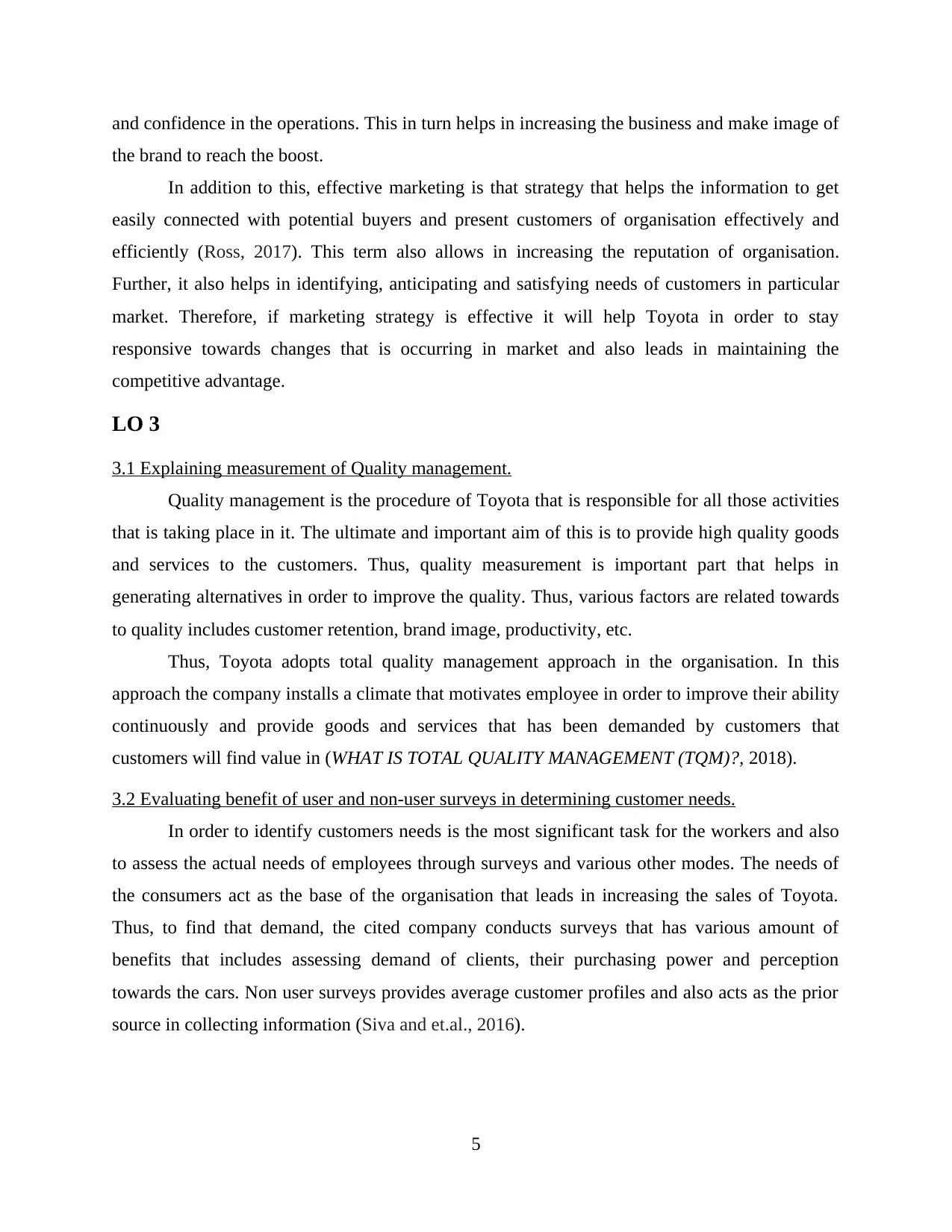
and confidence in the operations. This in turn helps in increasing the business and make image of
the brand to reach the boost.
In addition to this, effective marketing is that strategy that helps the information to get
easily connected with potential buyers and present customers of organisation effectively and
efficiently (Ross, 2017). This term also allows in increasing the reputation of organisation.
Further, it also helps in identifying, anticipating and satisfying needs of customers in particular
market. Therefore, if marketing strategy is effective it will help Toyota in order to stay
responsive towards changes that is occurring in market and also leads in maintaining the
competitive advantage.
LO 3
3.1 Explaining measurement of Quality management.
Quality management is the procedure of Toyota that is responsible for all those activities
that is taking place in it. The ultimate and important aim of this is to provide high quality goods
and services to the customers. Thus, quality measurement is important part that helps in
generating alternatives in order to improve the quality. Thus, various factors are related towards
to quality includes customer retention, brand image, productivity, etc.
Thus, Toyota adopts total quality management approach in the organisation. In this
approach the company installs a climate that motivates employee in order to improve their ability
continuously and provide goods and services that has been demanded by customers that
customers will find value in (WHAT IS TOTAL QUALITY MANAGEMENT (TQM)?, 2018).
3.2 Evaluating benefit of user and non-user surveys in determining customer needs.
In order to identify customers needs is the most significant task for the workers and also
to assess the actual needs of employees through surveys and various other modes. The needs of
the consumers act as the base of the organisation that leads in increasing the sales of Toyota.
Thus, to find that demand, the cited company conducts surveys that has various amount of
benefits that includes assessing demand of clients, their purchasing power and perception
towards the cars. Non user surveys provides average customer profiles and also acts as the prior
source in collecting information (Siva and et.al., 2016).
5
the brand to reach the boost.
In addition to this, effective marketing is that strategy that helps the information to get
easily connected with potential buyers and present customers of organisation effectively and
efficiently (Ross, 2017). This term also allows in increasing the reputation of organisation.
Further, it also helps in identifying, anticipating and satisfying needs of customers in particular
market. Therefore, if marketing strategy is effective it will help Toyota in order to stay
responsive towards changes that is occurring in market and also leads in maintaining the
competitive advantage.
LO 3
3.1 Explaining measurement of Quality management.
Quality management is the procedure of Toyota that is responsible for all those activities
that is taking place in it. The ultimate and important aim of this is to provide high quality goods
and services to the customers. Thus, quality measurement is important part that helps in
generating alternatives in order to improve the quality. Thus, various factors are related towards
to quality includes customer retention, brand image, productivity, etc.
Thus, Toyota adopts total quality management approach in the organisation. In this
approach the company installs a climate that motivates employee in order to improve their ability
continuously and provide goods and services that has been demanded by customers that
customers will find value in (WHAT IS TOTAL QUALITY MANAGEMENT (TQM)?, 2018).
3.2 Evaluating benefit of user and non-user surveys in determining customer needs.
In order to identify customers needs is the most significant task for the workers and also
to assess the actual needs of employees through surveys and various other modes. The needs of
the consumers act as the base of the organisation that leads in increasing the sales of Toyota.
Thus, to find that demand, the cited company conducts surveys that has various amount of
benefits that includes assessing demand of clients, their purchasing power and perception
towards the cars. Non user surveys provides average customer profiles and also acts as the prior
source in collecting information (Siva and et.al., 2016).
5
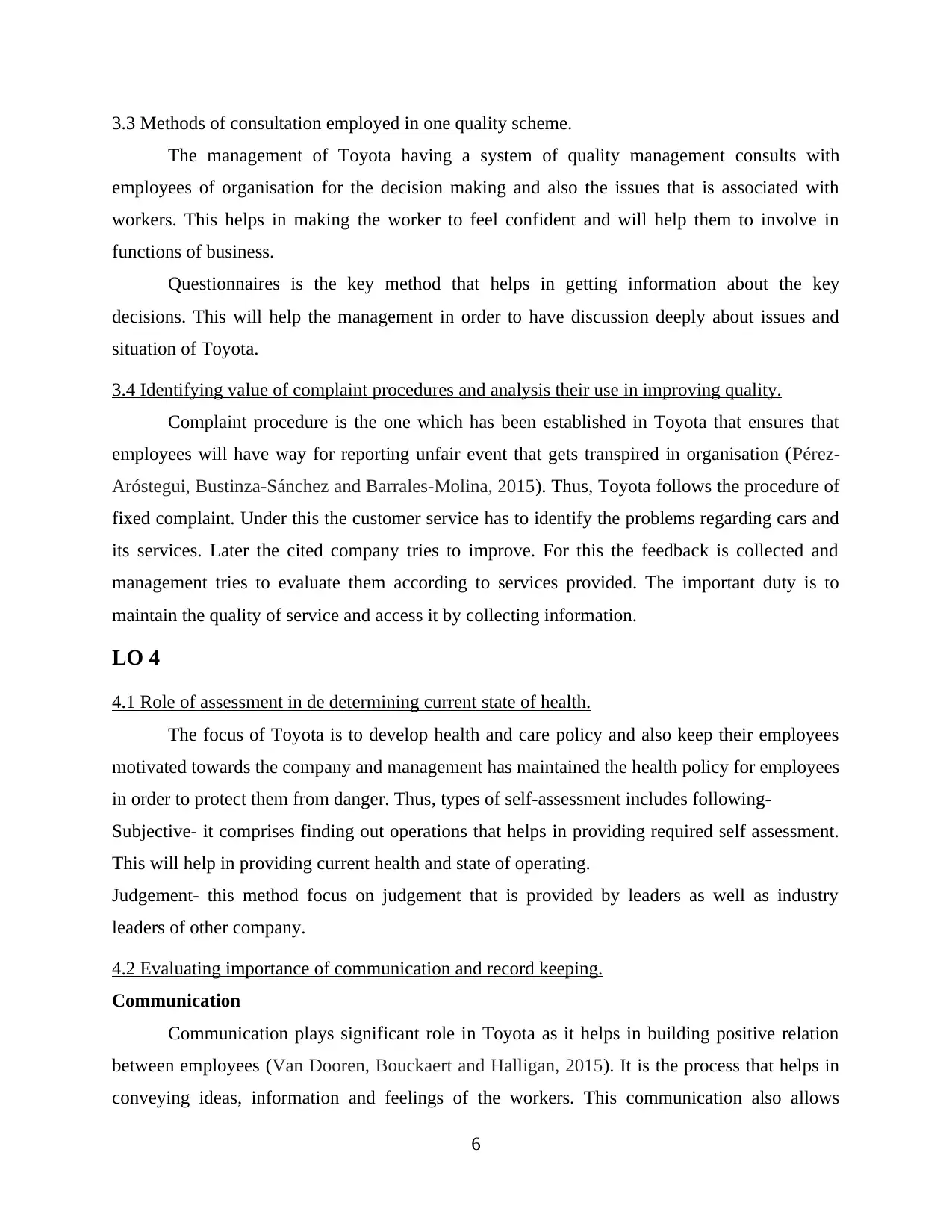
3.3 Methods of consultation employed in one quality scheme.
The management of Toyota having a system of quality management consults with
employees of organisation for the decision making and also the issues that is associated with
workers. This helps in making the worker to feel confident and will help them to involve in
functions of business.
Questionnaires is the key method that helps in getting information about the key
decisions. This will help the management in order to have discussion deeply about issues and
situation of Toyota.
3.4 Identifying value of complaint procedures and analysis their use in improving quality.
Complaint procedure is the one which has been established in Toyota that ensures that
employees will have way for reporting unfair event that gets transpired in organisation (Pérez-
Aróstegui, Bustinza-Sánchez and Barrales-Molina, 2015). Thus, Toyota follows the procedure of
fixed complaint. Under this the customer service has to identify the problems regarding cars and
its services. Later the cited company tries to improve. For this the feedback is collected and
management tries to evaluate them according to services provided. The important duty is to
maintain the quality of service and access it by collecting information.
LO 4
4.1 Role of assessment in de determining current state of health.
The focus of Toyota is to develop health and care policy and also keep their employees
motivated towards the company and management has maintained the health policy for employees
in order to protect them from danger. Thus, types of self-assessment includes following-
Subjective- it comprises finding out operations that helps in providing required self assessment.
This will help in providing current health and state of operating.
Judgement- this method focus on judgement that is provided by leaders as well as industry
leaders of other company.
4.2 Evaluating importance of communication and record keeping.
Communication
Communication plays significant role in Toyota as it helps in building positive relation
between employees (Van Dooren, Bouckaert and Halligan, 2015). It is the process that helps in
conveying ideas, information and feelings of the workers. This communication also allows
6
The management of Toyota having a system of quality management consults with
employees of organisation for the decision making and also the issues that is associated with
workers. This helps in making the worker to feel confident and will help them to involve in
functions of business.
Questionnaires is the key method that helps in getting information about the key
decisions. This will help the management in order to have discussion deeply about issues and
situation of Toyota.
3.4 Identifying value of complaint procedures and analysis their use in improving quality.
Complaint procedure is the one which has been established in Toyota that ensures that
employees will have way for reporting unfair event that gets transpired in organisation (Pérez-
Aróstegui, Bustinza-Sánchez and Barrales-Molina, 2015). Thus, Toyota follows the procedure of
fixed complaint. Under this the customer service has to identify the problems regarding cars and
its services. Later the cited company tries to improve. For this the feedback is collected and
management tries to evaluate them according to services provided. The important duty is to
maintain the quality of service and access it by collecting information.
LO 4
4.1 Role of assessment in de determining current state of health.
The focus of Toyota is to develop health and care policy and also keep their employees
motivated towards the company and management has maintained the health policy for employees
in order to protect them from danger. Thus, types of self-assessment includes following-
Subjective- it comprises finding out operations that helps in providing required self assessment.
This will help in providing current health and state of operating.
Judgement- this method focus on judgement that is provided by leaders as well as industry
leaders of other company.
4.2 Evaluating importance of communication and record keeping.
Communication
Communication plays significant role in Toyota as it helps in building positive relation
between employees (Van Dooren, Bouckaert and Halligan, 2015). It is the process that helps in
conveying ideas, information and feelings of the workers. This communication also allows
6
⊘ This is a preview!⊘
Do you want full access?
Subscribe today to unlock all pages.

Trusted by 1+ million students worldwide
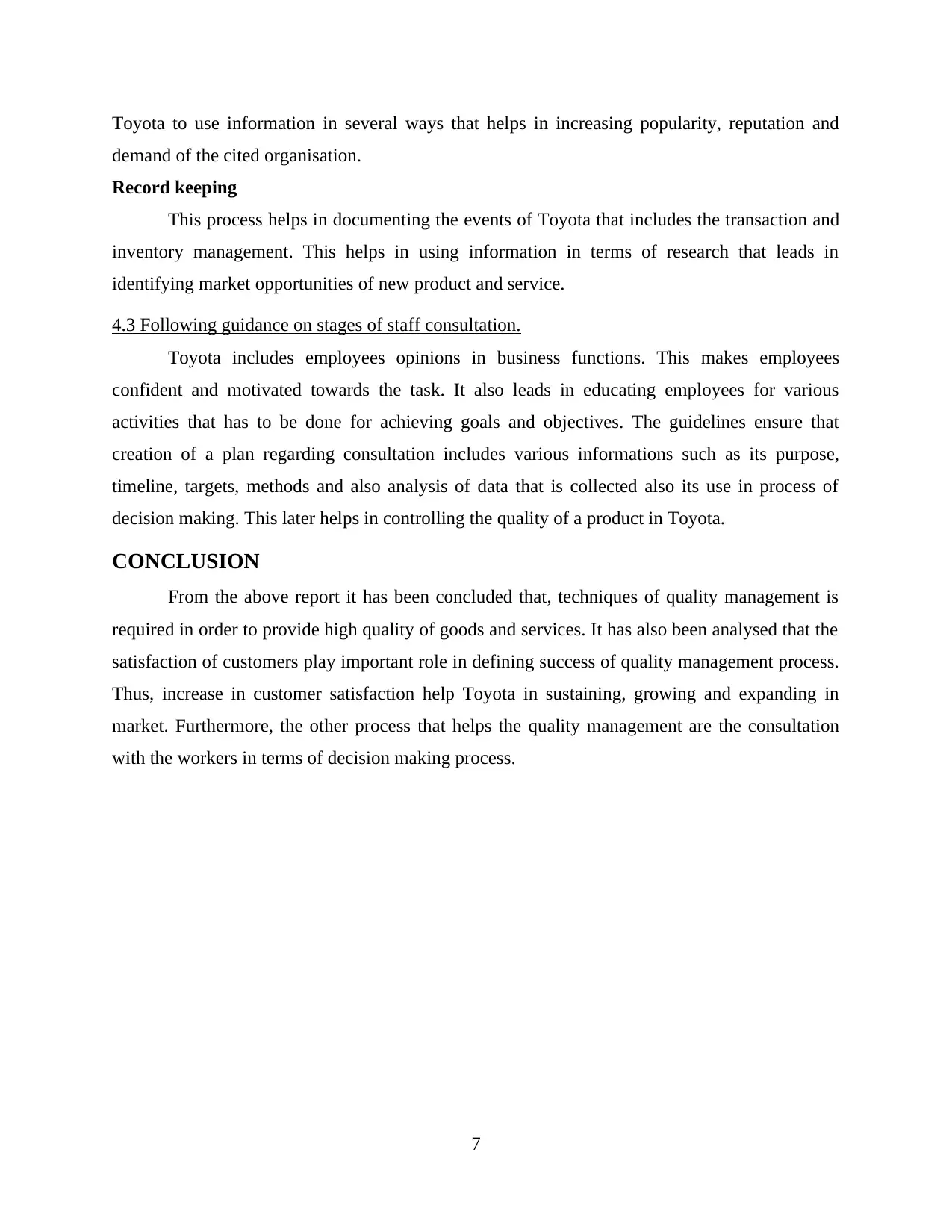
Toyota to use information in several ways that helps in increasing popularity, reputation and
demand of the cited organisation.
Record keeping
This process helps in documenting the events of Toyota that includes the transaction and
inventory management. This helps in using information in terms of research that leads in
identifying market opportunities of new product and service.
4.3 Following guidance on stages of staff consultation.
Toyota includes employees opinions in business functions. This makes employees
confident and motivated towards the task. It also leads in educating employees for various
activities that has to be done for achieving goals and objectives. The guidelines ensure that
creation of a plan regarding consultation includes various informations such as its purpose,
timeline, targets, methods and also analysis of data that is collected also its use in process of
decision making. This later helps in controlling the quality of a product in Toyota.
CONCLUSION
From the above report it has been concluded that, techniques of quality management is
required in order to provide high quality of goods and services. It has also been analysed that the
satisfaction of customers play important role in defining success of quality management process.
Thus, increase in customer satisfaction help Toyota in sustaining, growing and expanding in
market. Furthermore, the other process that helps the quality management are the consultation
with the workers in terms of decision making process.
7
demand of the cited organisation.
Record keeping
This process helps in documenting the events of Toyota that includes the transaction and
inventory management. This helps in using information in terms of research that leads in
identifying market opportunities of new product and service.
4.3 Following guidance on stages of staff consultation.
Toyota includes employees opinions in business functions. This makes employees
confident and motivated towards the task. It also leads in educating employees for various
activities that has to be done for achieving goals and objectives. The guidelines ensure that
creation of a plan regarding consultation includes various informations such as its purpose,
timeline, targets, methods and also analysis of data that is collected also its use in process of
decision making. This later helps in controlling the quality of a product in Toyota.
CONCLUSION
From the above report it has been concluded that, techniques of quality management is
required in order to provide high quality of goods and services. It has also been analysed that the
satisfaction of customers play important role in defining success of quality management process.
Thus, increase in customer satisfaction help Toyota in sustaining, growing and expanding in
market. Furthermore, the other process that helps the quality management are the consultation
with the workers in terms of decision making process.
7
Paraphrase This Document
Need a fresh take? Get an instant paraphrase of this document with our AI Paraphraser
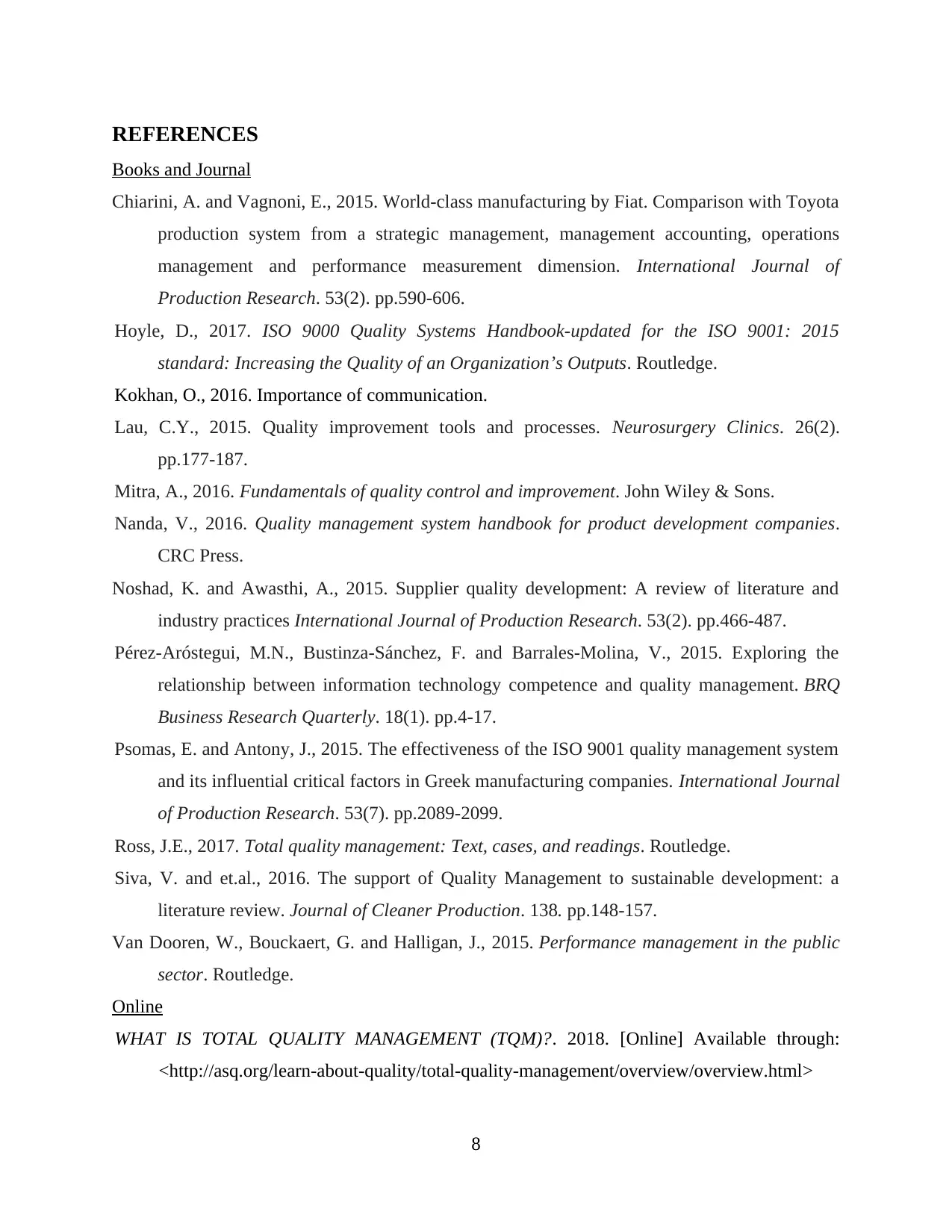
REFERENCES
Books and Journal
Chiarini, A. and Vagnoni, E., 2015. World-class manufacturing by Fiat. Comparison with Toyota
production system from a strategic management, management accounting, operations
management and performance measurement dimension. International Journal of
Production Research. 53(2). pp.590-606.
Hoyle, D., 2017. ISO 9000 Quality Systems Handbook-updated for the ISO 9001: 2015
standard: Increasing the Quality of an Organization’s Outputs. Routledge.
Kokhan, O., 2016. Importance of communication.
Lau, C.Y., 2015. Quality improvement tools and processes. Neurosurgery Clinics. 26(2).
pp.177-187.
Mitra, A., 2016. Fundamentals of quality control and improvement. John Wiley & Sons.
Nanda, V., 2016. Quality management system handbook for product development companies.
CRC Press.
Noshad, K. and Awasthi, A., 2015. Supplier quality development: A review of literature and
industry practices International Journal of Production Research. 53(2). pp.466-487.
Pérez-Aróstegui, M.N., Bustinza-Sánchez, F. and Barrales-Molina, V., 2015. Exploring the
relationship between information technology competence and quality management. BRQ
Business Research Quarterly. 18(1). pp.4-17.
Psomas, E. and Antony, J., 2015. The effectiveness of the ISO 9001 quality management system
and its influential critical factors in Greek manufacturing companies. International Journal
of Production Research. 53(7). pp.2089-2099.
Ross, J.E., 2017. Total quality management: Text, cases, and readings. Routledge.
Siva, V. and et.al., 2016. The support of Quality Management to sustainable development: a
literature review. Journal of Cleaner Production. 138. pp.148-157.
Van Dooren, W., Bouckaert, G. and Halligan, J., 2015. Performance management in the public
sector. Routledge.
Online
WHAT IS TOTAL QUALITY MANAGEMENT (TQM)?. 2018. [Online] Available through:
<http://asq.org/learn-about-quality/total-quality-management/overview/overview.html>
8
Books and Journal
Chiarini, A. and Vagnoni, E., 2015. World-class manufacturing by Fiat. Comparison with Toyota
production system from a strategic management, management accounting, operations
management and performance measurement dimension. International Journal of
Production Research. 53(2). pp.590-606.
Hoyle, D., 2017. ISO 9000 Quality Systems Handbook-updated for the ISO 9001: 2015
standard: Increasing the Quality of an Organization’s Outputs. Routledge.
Kokhan, O., 2016. Importance of communication.
Lau, C.Y., 2015. Quality improvement tools and processes. Neurosurgery Clinics. 26(2).
pp.177-187.
Mitra, A., 2016. Fundamentals of quality control and improvement. John Wiley & Sons.
Nanda, V., 2016. Quality management system handbook for product development companies.
CRC Press.
Noshad, K. and Awasthi, A., 2015. Supplier quality development: A review of literature and
industry practices International Journal of Production Research. 53(2). pp.466-487.
Pérez-Aróstegui, M.N., Bustinza-Sánchez, F. and Barrales-Molina, V., 2015. Exploring the
relationship between information technology competence and quality management. BRQ
Business Research Quarterly. 18(1). pp.4-17.
Psomas, E. and Antony, J., 2015. The effectiveness of the ISO 9001 quality management system
and its influential critical factors in Greek manufacturing companies. International Journal
of Production Research. 53(7). pp.2089-2099.
Ross, J.E., 2017. Total quality management: Text, cases, and readings. Routledge.
Siva, V. and et.al., 2016. The support of Quality Management to sustainable development: a
literature review. Journal of Cleaner Production. 138. pp.148-157.
Van Dooren, W., Bouckaert, G. and Halligan, J., 2015. Performance management in the public
sector. Routledge.
Online
WHAT IS TOTAL QUALITY MANAGEMENT (TQM)?. 2018. [Online] Available through:
<http://asq.org/learn-about-quality/total-quality-management/overview/overview.html>
8
1 out of 11
Related Documents
Your All-in-One AI-Powered Toolkit for Academic Success.
+13062052269
info@desklib.com
Available 24*7 on WhatsApp / Email
![[object Object]](/_next/static/media/star-bottom.7253800d.svg)
Unlock your academic potential
Copyright © 2020–2025 A2Z Services. All Rights Reserved. Developed and managed by ZUCOL.





